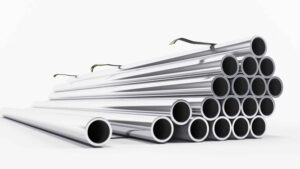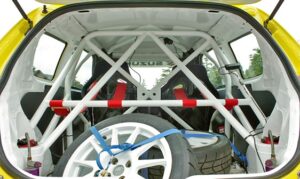Automotive roll cages are critical components that enhance the structural integrity of vehicles, particularly in motorsports and high-performance contexts. These frameworks are designed to protect occupants in the event of a rollover or severe crash by reinforcing the cabin structure. Understanding the construction of roll cages is vital for anyone involved in automotive racing or vehicle modification dedicated to safety.
What Tools Are Necessary for Constructing a Roll Cage?
Building a roll cage requires specialized tools that ensure the safety and effectiveness of the final product. Below are the essential tools needed, along with a description of each tool’s purpose:
- Tube Cutter: Precisely cuts metal tubes without deforming the material.
- Tube Bender: Curves tubes accurately to fit the vehicle’s dimensions without weakening the metal. With the help of Tube Benders Roguefab, the bending process is easier.
- Welding Machine: Joins metal pieces securely to form the cage.
- Notcher: Creates joints between tubes that help maintain strength at connections.
- Calipers and Measuring Tape: Ensures precise measurements for cutting and fitting.
Measuring and Cutting Tools
Accurate measurement and cutting are foundational in roll cage construction. Tools such as electronic calipers, angle finders, and specialized tube cutters are used to ensure that each piece of the cage matches the design specifications exactly, which is crucial for the integrity of the cage.
Bending Tools
Metal tubes must be bent to specific angles to fit the vehicle’s profile without compromising their strength. Hydraulic and manual tube benders are common tools in this process, allowing for precise control over the bend radius and angle.
Welding Equipment
Welding is a critical skill in roll cage construction. TIG (Tungsten Inert Gas) and MIG (Metal Inert Gas) welders are the most commonly used. Each tool offers different benefits; TIG is known for its precision and strength, making it ideal for welding critical load-bearing joints, while MIG can be used for quicker jobs where appearance is less critical.
How to Choose the Right Materials for a Roll Cage?

Selecting the appropriate materials is crucial for ensuring the roll cage can withstand extreme stress and protect occupants. Here are some of the best materials:
- DOM Steel Tubing: Offers excellent strength and durability, commonly used in roll cage construction.
- 4130 Chromoly Steel: Lighter than DOM steel and extremely strong, used for professional racing applications.
- Carbon Fiber: Used in high-end applications for its strength-to-weight ratio, though much more expensive.
Comparing Steel vs. Aluminum for Roll Cages
Steel is typically preferred for its superior strength and flexibility under stress, which are crucial in impact absorption. Aluminum, while lighter, is less commonly used due to its higher likelihood of failing under the same impacts.
Step-by-Step Guide to Building a Roll Cage
The construction of a roll cage involves detailed planning and execution. Here is a structured list of steps to follow:
- Design Planning: Tailor the cage design to fit specific vehicle dimensions and intended use.
- Material Selection: Choose materials based on the balance of strength, weight, and cost.
- Cutting and Shaping: Measure twice and cut once, then shape the tubes as needed.
- Assembly and Welding: Tack welds all parts together to check the fit before final welding.
- Inspection and Testing: Ensure the cage meets safety standards through rigorous testing.
Designing the Roll Cage
Considerations include the type of racing, vehicle structure, and the level of protection needed. Software tools can help simulate stress points and optimize the design.
Cutting and Shaping the Metal
Precision in cutting and shaping ensures that the tubes fit together without gaps, which is critical for the welding process.
Welding the Structure
Effective welding techniques are crucial for ensuring that the roll cage will perform as expected in the event of a crash. Proper penetration and bead formation are key factors in strong welds.
What Are the Safety Standards for Automotive Roll Cages?

Safety standards for roll cages are set by organizations like the FIA (Fédération Internationale de l’Automobile) and SFI (Safety Foundation, Inc.). These guidelines ensure that roll cages provide maximum protection.
Understanding FIA and SFI Specifications
The FIA and SFI provide detailed specifications on materials, design, and construction methods. These standards help guide builders in creating cages that meet rigorous safety requirements.
Common Mistakes to Avoid When Building a Roll Cage
It’s crucial to avoid common pitfalls that can compromise the cage’s integrity:
- Improper Material Handling: Using damaged or substandard materials can lead to failure.
- Inadequate Welding Techniques: Poor welding can be the weakest link in a roll cage’s safety.
How to Inspect and Test a Roll Cage?
Post-construction, a roll cage must be thoroughly inspected and tested to ensure it meets safety standards:
Visual Inspection Techniques
Look for consistent weld seams, proper alignment, and the absence of cracks or rust.
Stress Testing Methods
Applying controlled forces to simulate real-world stresses can help verify the strength and durability of the cage.
Tools and Tips for Maintaining a Roll Cage

Maintaining a roll cage is essential for its longevity and performance. Regular checkups should include inspecting for cracks, corrosion, and loose fittings, especially after any incident or at regular racing intervals.
Routine Checkup and Maintenance
Regular inspections can identify potential issues before they become critical, ensuring the roll cage remains in optimal condition.
When to Replace Parts of a Roll Cage
Parts of the roll cage should be replaced if they show signs of significant wear, or deformation, or after a major impact.
Innovations in Roll Cage Design and Materials
Advancements in materials science and design techniques continue to push the boundaries of what is possible with roll cages. Newer materials like advanced alloys and composite materials offer improved performance and safety.
Conclusion
Building an effective and safe roll cage is a complex but rewarding endeavor that combines engineering, precision craftsmanship, and an understanding of materials science. By following these guidelines, builders can ensure that their roll cages provide maximum protection in any racing or performance scenario.